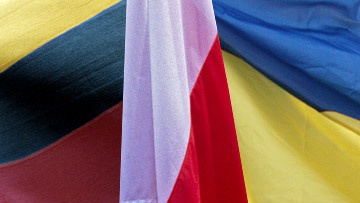
From East-West to North-South: Moscow’s Actions in Ukraine Reignite Talk of a Baltic–Black Sea Union
Publication: Eurasia Daily Monitor Volume: 11 Issue: 99
By:

For most of the last half-millennium, the lands between Moscow and Berlin have thought of themselves and been thought about by others almost exclusively in terms of an east-west axis, as a battleground between the Russian state and European countries. But before that, they were conceived almost equally exclusively in terms of a north-south axis, one connecting, via a complex set of waterways and trade routes, the Scandinavian world of the Vikings in the north with enormously powerful Byzantium in the south.
Only occasionally over the last century has this earlier pattern been recalled: in the proposed Intermarium Federation or the Promethean League set up by Marshal Jozef Pilsudski of interwar Poland; in Estonian President Lennart Meri’s “Silver White,” which reconstructed Estonia and the Baltic region’s history; and even a series of postage stamps jointly issued by Estonia and Ukraine a decade ago. But in most cases, these were viewed by everyone as part of the defense strategy of these countries against Russian power—and thus as little more than curiosities.
But that appears to be changing, particularly in the face of renewed Russian aggression against Ukraine, Ukrainian resistance to that aggression, and the shared interest of other countries in the region that Ukraine succeed and Russia fail lest it redirect its attentions on them. Illustratively, in a May 14 interview with Rufabala.com, Janis Ratkevics, a Latvian politician who currently serves as an advisor to the environment and regional development minister of his country, suggests that discussions about expanding north-south ties in this region are becoming ever more frequent (rufabula.com/articles/2014/05/14/janis-ratkevics).
Asked directly by the site about the possibilities for “a Black Sea–Baltic union,” Ratkevics says he is very much aware of this idea because it is actively being discussed on the Internet and in private conversations, “but so far there have not been any concrete steps.” However, he continued, in his view, “such a union is inevitable given that these counties live as neighbors to such an aggressive state as the Russian Federation.”
“It is possible,” the Latvian politician continues, “that the format will be even broader and include Georgia and Azerbaijan, countries which also have chosen a European path of development.” And he says that “one must not repeat the errors of the 1930s and 1940s, when the democratic countries operated separately” rather than in the closest coordination. “We must learn the lessons of history.”
Elsewhere in his interview, Ratkevics makes clear the most important reason for “the countries in between”—as they are often known—to come together and change the axis of their relations. Specifically, he notes that this sudden change stems from Moscow’s success in gaining influence politically, economically and culturally in Western Europe. He notes that the Western European countries and peoples have never had the experience of Soviet Russian occupation and thus are prepared to view the Russian state not as the revisionist power that it has become under Vladimir Putin but rather as an important part of the concert of Europe. And with such Russian influence has come something else that is inherently disturbing to the countries from the Baltic to the Black Sea: a desire by Moscow and a willingness by Western Europe to decide the fate of this swath of countries in violation of what has long been the bedrock principle in this region, one captured in the slogan “nothing about us without us.”
Individually, the countries in this region can do relatively little to counter such political efforts, but collectively they have a chance, given the enormous size of the region, its large population, and its growing markets. Over the past decade, these countries have developed some of their largest embassies within each other’s capitals, their leaders have exchanged visits—most prominently when the Baltic, Ukrainian and Polish leaders went to Tbilisi after Putin attacked Georgia in August 2008 (The Baltic Times, August 13, 2008). And they have issued statements of support, including in recent weeks for Ukraine, against Russia’s anschluss of Crimea and its continuing interference in Ukrainian affairs (Lithuanian Ministry of Foreign Affairs, May 15, 25; https://www.visegradgroup.eu/calendar/2014/statement-of-the).
What form could such cooperation take in the future? The obvious answer is something like an expanded GUAM—the grouping of Georgia, Ukraine, Azerbaijan and Moldova, which seeks to promote democratization, human rights and trade within the post-Soviet space. Were the Baltic countries, which are members of the North Atlantic Treaty Organization (NATO) and the European Union, also to join that group, it would become far more significant as a regional player. At the very least, it would put Moscow on notice that these countries have a collective interest, one defined by their opposition to what Vladimir Putin is doing. Furthermore, cooperative hard security formations, such as the planned Lithuanian-Polish-Ukrainian brigade (LITPOLUKRBRIG), which the Ukrainian government recently approved taking part in, will provide further means for bolstering regional security preparedness (dsnews.ua, May 27).
Beyond question, Russia will do everything it can to prevent the growth of such a north-south union. Notably, Moscow played a key role in detaching Uzbekistan, which had been a member of the then five-member GUUAM (Civil Georgia, December 29, 2005; https://cyberleninka.ru/article/n/russia-and-guam). And it is possible that many in the West would be made uncomfortable by the region’s reorientation from an east-west to a north-south axis. But if Russian aggression continues and if Western Europe fails to take a tough stand, a Baltic–Black Sea combination will become ever more likely.




